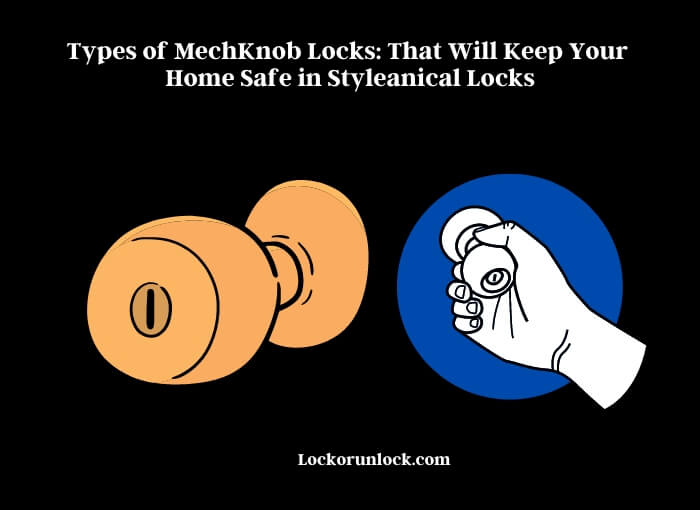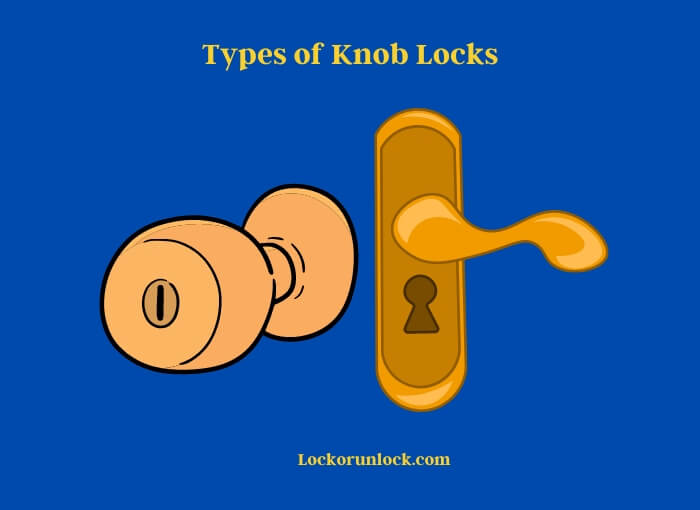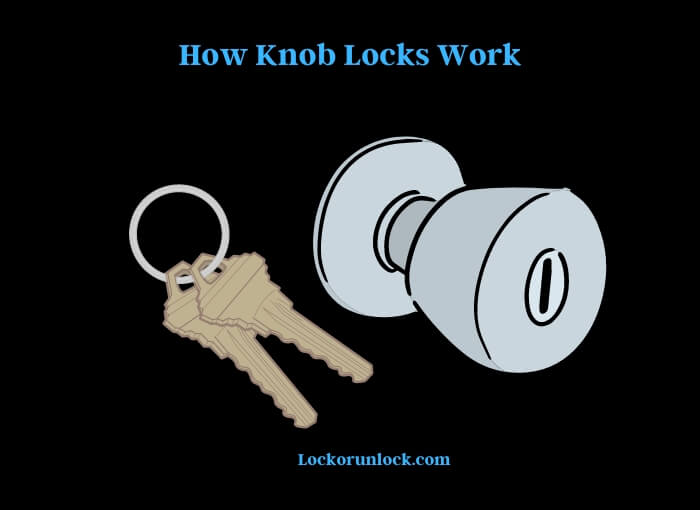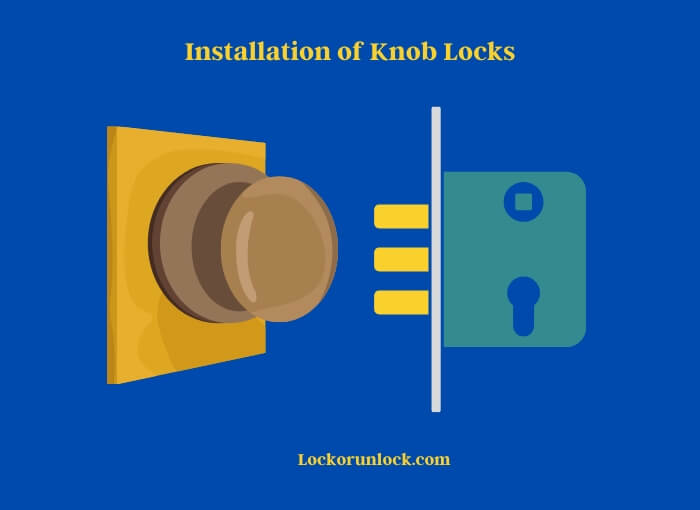Knob locks are a fundamental component of residential and commercial security systems. They are widely used for interior doors, such as bedrooms, bathrooms, closets, and cabinets, and offer a basic level of security against unauthorized entry. Knob locks are easy to operate, affordable, and come in different finishes and styles to match your decor. They are also easy to install, making them a popular choice for DIY enthusiasts.

While knob locks are a popular choice for many property owners, it is important to understand their limitations. Knob locks are not as secure as deadbolts and can be easily picked or bumped. Moreover, they tend to wear out quickly and require regular maintenance to keep them functioning properly.
Types of Knob Locks
Knob locks come in four basic types: passage, privacy, dummy, and keyed. Each type of knob lock serves a different purpose and is designed for a specific application.
Passage Knob Locks
Passage knob locks do not have a locking mechanism and are used for interior doors that do not require security, such as closet doors and pantry doors. Passage knob locks allow the door to be opened without a key or any other form of authentication. These locks are easy to operate and do not require any special skills to install.
Privacy Knob Locks
Privacy knob locks are designed for use on bedroom and bathroom doors where privacy is required. They have a locking mechanism that can be engaged from the inside by turning a small knob or button. Privacy knob locks are ideal for preventing unwanted intrusion and are easy to use and install.

Dummy Knob Locks
Dummy knob locks are not designed to provide security, but rather to serve as decorative or functional elements. These locks are installed on cabinet doors, drawers, or other types of furniture to create a consistent aesthetic. Dummy knob locks do not have a locking mechanism and are only used for their decorative or functional value.
Keyed Knob Locks
Keyed knob locks provide the highest level of security among all types of knob locks. They are used on exterior doors and have a locking mechanism that requires a key to unlock the door. Keyed knob locks are commonly used in conjunction with deadbolts to provide maximum security for your property. These locks are easy to install and operate, and they offer a good level of protection against unauthorized entry.
How do Knob Locks Work?
Knob locks work by using a spring-loaded latch that is held in place by a small knob or button on one side of the door. When the knob or button is turned, the latch retracts, allowing the door to be opened.
The latch mechanism of a knob lock is controlled by a small metal plate called a strike plate that is mounted on the door frame. The strike plate has a small hole that the latch fits into when the door is closed. When the latch is engaged, it is held in place by the strike plate, preventing the door from being opened.
Privacy knob locks work in a similar way, but they have an additional locking mechanism that can be engaged from the inside. This locking mechanism is controlled by a small button or knob located on the interior side of the lock. When the button or knob is turned, the latch is retracted and the locking mechanism is engaged, preventing the door from being opened from the outside.

Keyed knob locks work in the same way as privacy knob locks, but they have an additional locking mechanism that requires a key to unlock the door from the outside. This locking mechanism is controlled by a cylinder located in the knob. When the key is inserted into the cylinder and turned, it rotates a series of pins allowing the lock to be disengaged and the door to be opened.
Pros and Cons of Knob Locks
Knob locks are a popular choice for many property owners because they are easy to use, affordable, and come in different finishes and styles. However, like any security system, they have their pros and cons.
Pros
Easy to Install: Knob locks are easy to install and do not require any special skills or tools. This makes them a popular choice for DIY enthusiasts who want to save money on installation costs.
Easy to Operate: Knob locks are easy to operate and do not require a key or any other form of authentication. This makes them a convenient option for interior doors that do not require high-level security.
Affordable: Knob locks are an affordable option for securing your property. They are cheaper than deadbolts and other high-security locks, making them a popular choice for those on a budget.
Stylish: Knob locks come in different finishes and styles, making them a great option for those who want to match their locks with their decor.
Cons
Limited Security: Knob locks provide a basic level of security, but they are not as secure as deadbolts or other high-security locks. They can be easily picked up or bumped by experienced intruders.
Wear and Tear: Knob locks tend to wear out quickly and require regular maintenance to keep them functioning properly. This can be a hassle for property owners who do not want to spend time and money on maintenance.
Easy to Break: Knob locks can be easily broken by brute force, making them an easy target for intruders who are looking for a quick entry into your property.
How to Installation of Knob Locks?
Installing a knob lock is a straightforward process that can be completed in a few simple steps.

| Gather the necessary tools and materials | You will need a knob lockset, a drill, a screwdriver, measuring tape, and a pencil. |
| Measure the door | Measure the height and width of the door to determine where the lockset will be installed. Typically, knob locks are installed 2-3/8 inches or 2-3/4 inches from the edge of the door. |
| Mark the door | Use a pencil to mark the center of the lockset on both sides of the door. |
| Install the latch | Using the drill, create a hole for the latch on the edge of the door where you marked the center. Install the latch by inserting it into the hole and securing it with screws. |
| Install the strike plate | Place the strike plate on the door frame where the latch will meet it. Mark the screw holes with a pencil, and then screw the strike plate in place. |
| Install the knob | Insert the knobs into the holes on both sides of the door. Secure the knobs with screws. |
| Test the lock | Make sure the lock is functioning properly by testing it several times. The latch should retract and extend smoothly, and the door should open and close easily. |
| Adjust the strike plate | If the lock is not functioning properly, you may need to adjust the strike plate. This can be done by loosening the screws and moving the plate up or down until the latch aligns with the hole. |
Tips for Maintenance and Troubleshooting
Maintaining your knob lock is essential to ensure its proper functioning and longevity.
Lubrication
Regularly lubricate your lock with a silicone-based lubricant to keep it functioning smoothly. Avoid using oil-based lubricants, which can attract dust and dirt and cause your lock to malfunction.
Cleaning
Clean your lock periodically with a soft, dry cloth to remove any dirt or debris that may have accumulated. Avoid using abrasive cleaners or chemicals, which can damage the finish of your lock.
Tighten Loose Screws
Check the screws on your lock periodically to ensure they are tight. Loose screws can cause your lock to malfunction and should be tightened as soon as possible.
Check the Door Alignment
If your lock is not functioning properly, check the alignment of your door. A misaligned door can cause your lock to stick or not function at all.
Key Insertion Issues
If you are having trouble inserting your key, try cleaning the key or using a different key. If the problem persists, there may be an issue with the lock cylinder that requires professional attention.
Jams or Sticking
If your lock is jamming or sticking, try lubricating it or adjusting the strike plate. If these steps do not resolve the issue, there may be an issue with the lock mechanism that requires professional attention.
Replace Worn Parts
If any part of your lock is worn or damaged, it should be replaced promptly to ensure proper functioning and security.
Conclusion
Knob locks are a popular and effective type of lock that provides the basic security for residential and commercial doors. They are easy to install, affordable, and available in various styles to fit your aesthetic preferences.
There are different types of knob locks, including keyed knob locks, privacy knob locks, and passage knob locks, each with its unique features and benefits. Understanding how knob locks work and their pros and cons can help you determine whether they are the right choice for your security needs.
When installing a knob lock, it is essential to follow the proper installation procedure to ensure that it is functioning correctly. Additionally, maintaining and troubleshooting your knob lock regularly can help prevent malfunctions and extend its lifespan.
